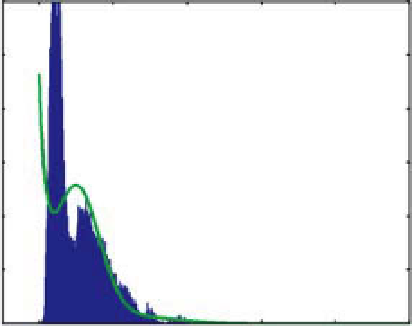Geography Reference
In-Depth Information
are tracked in natural environments, themore researchers
are discovering new spatial behaviour corresponding to
different tactics of habitat exploitation by fish.
For example, Bujold (2010) recently used stationary
passive integrated transponder (PIT) systems to provide
continuous remote monitoring of the longitudinal move-
ment of PIT-tagged juvenile salmonids along a 2.5 km-
long section of a small tributary of the Sainte-Marguerite
River (Quebec, Canada). This approach allowed the iden-
tification of a new type of spatial behaviour characterising
fish that were called 'commuters' because of their ten-
dency to enter the tributary at sunrise, travel upstream
often as far as 2.5 km, and return to the Sainte-Marguerite
River before sunset. This peculiar spatial behaviour
applied to 16% of the PIT-tagged individuals, a group
too large to be ignored when investigating fish/habitat
relationships.
Similarly interesting results were obtained by Roy, M.
(
unpublished data
, Department of geography, University
of Montreal.) in a study of juvenile Atlantic salmon
individual mobility using a large array of passive
integrated transponder antennas buried in the bed of
a natural stream. This system, described in details in
Johnston et al. (2009), allowed the continuous remote
monitoring of PIT-tagged fish locations at high spatial
and temporal frequency, from which four types of daily
behaviour were identified: stationary, sedentary (low
mobility), floater (frequent movements in restricted
home range) and explorer (movements across the reach).
The surprising result is that most individual fish were
found to exhibit all types of daily behaviour during the
study period, thus challenging the traditional description
of a population composed of fractions of sedentary and
mobile individuals.
The studies described above are examples amongst
others suggesting that how fish exploit the habitat mosaic
of the riverscape is probably far from being a resolved
issue. More research is thus required in order to assess
the geographic path of fish moving from one habitat to
the other throughout their lifetime. Such information
will allow predictions to be made of how fish are affected
by anthropogenic disturbances causing a modification of
the available habitat or a reduction of the connectivity
between the different habitats comprising the riverscape.
1.2
1
0.8
0.6
0.4
0.2
0
0
2 4
Normalised velocity (V/u
*
)
6
8
10
Figure 9.16
Velocity validation. This figure shows, in blue,
the distribution of the Normalised velocity (V/u
∗
)
(see Equation 9.1) for the data presented in Figure 9.15. In
green, we show the velocity distributions as predicted by the
methods of Lamouroux et al. (1995). Both distributions have a
consistent shape.
distributions in Figure 9.15. Overall, the distributions are
similar which indicates that the direct velocity estimation
approach described here could potentially provide a valu-
able contribution to catchment scale velocity estimations.
9.7 Future work: Integrating fish
exploitation of the riverscape
Now that new remote sensing methods are available to
describe the riverscape at metric resolution, we suggest
that the necessary next step is to provide biological infor-
mation at similar scope on how fish exploit the mosaic
of habitats comprising the riverscape. While catch per
unit effort fish sampling techniques such as electrofish-
ing or snorkelling can reveal population-level patterns
of fish/habitat relationships, they cannot help understand
the processes causing the fishmovements that are creating
these patterns.
We therefore suggest that more progress will be made
by aiming to document how individual fish move across
the riverscape throughout their life time in order to access
the various habitats they need at different life stages
to complete their life-cycle. The well-known distinction
in fish spatial behaviour between 'stayers' and 'movers'
exemplifies that given a set of habitat conditions, different
fish will exploit the habitat differently (Grant and Noakes,
1987). However, it appears that the more individual fish
9.8 Conclusion
Although the riverscape approach proposed by Fausch
et al. (2002) was
immediately perceived by stream






Search WWH ::

Custom Search